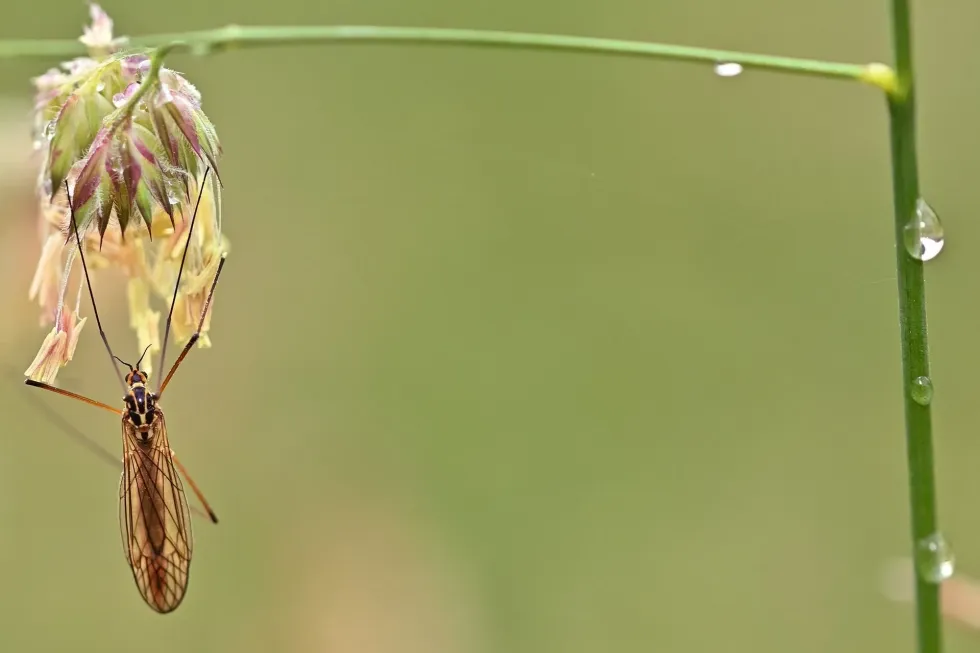Crane fly is a common term for any member of the Tipulidae family of true flies in the superfamily Tipulidae in the order Diptera.
Crown group crane flies have been around since the Barremian period of the Early Cretaceous, and they can be found all across the planet, however, particular species have limited ranges. They are most diverse in the tropics, although these aquatic insects can also be found at high elevations and in northern latitudes.
The description of adult crane flies includes them having a narrow body and deciduous stilt-like legs that readily come off the body, resembling a giant mosquito. In the late summer and fall, adult crane flies emerge from the earth beneath turfgrass, pastures, and other grassy regions. Adults have long legs and look like giant mosquitoes.
Within 24 hours of emergence, females mate and lay eggs on grass. The leatherjackets eat enough turfgrass, roots, stems, and leaves in October to inflict visible damage to lawns and golf courses.
Turf damage starts with a general thinning of the contaminated turf, but it can quickly proceed to massive dead spots. They are referred to as one of the most annoying pests.
Do you want to know more about crane fly larvae in water or crane fly larvae patterns? Then read on to discover more about these insects which are local to North America and are often referred to as shredders.
After reading about the populations of crane fly species found in a lawn during late summer, also check out related fact files on dragonfly larvae and mosquito larva in water, here on Kidadl.
Crane Fly Larvae Size
Crane flies are known to be enormous insects that look like giant mosquitoes once these aquatic insects become adult crane flies. Despite their 2 in (5 cm) wingspan, crane flies are awkward and weak fliers who are frequently spotted resting on the edge of a building or structure.
Unlike caterpillars, crane fly larvae, or maggots, are about 2-3 in (5.0-7.5 cm) long and have no legs. The larvae tend to grow a thick outer skin over time, earning them the preferred nickname 'leatherjackets'.
Crane fly larvae have segmented, wormlike bodies, a distinct head, and tiny, fleshy projections at the hind end. They resemble tan or grey 'grubs.' Some species are aquatic, while others are land-based. Adult crane flies, despite their threatening appearance due to their massive size, cannot bite and are not known to transmit human diseases.
Crane flies are the most common species in the genus Tipulan, in the United States. Adults measure between 0.5-0.8 in (13-20 mm) in length, excluding the legs.
Crane-fly larvae can harm a variety of field crops, such as turf, grazing, wild forestry, and agricultural crop beds. Crane flies that reside in temperate environments, such as Tipula species, can reach a size of 2.4 in (60 mm).
Crane flies in the tropics can reach a length of more than 3.93 in (100 mm). Holorusia mikado is considered the largest species of crane fly, with a wingspan of 10.16 in (25.8 cm), as observed in Chengdu, Sichuan, China.
Crane Fly Larvae Life Cycle
Adult Crane flies live for roughly 10-15 days, but larvae can survive anywhere from a few weeks to a year. Crane flies go through a complete metamorphosis, which means they go through all four stages of the life cycle. The four stages of the crane fly larvae life cycle are egg, larva, pupa, and adult.
Egg: The eggs are laid directly in the water or moist soil by the adult female. After mating, eggs are considered to be laid immediately by the female, and the egg stage is known to last for one to two weeks.
Larvae: It might take anywhere from a few weeks to a year for the larval stage to complete the life cycle. If the crane fly overwinters in the larval stage, it has a longer life span.
Crane flies burrow into damp soil, rotting plants, or submerge in water to overwinter as larvae. Crane-fly larvae go through four phases of growth, also called instars.
The larvae tend to leave the water sources during their last instar to pupate in surrounding soil, moss, or leaf litter. Crane flies have a life cycle that is considered more identical to that of their primary food sources.
As the larvae require fallen moist tree leaves or crowns to feed on, these aquatic insects must mature during the fall and winter.
As the larvae burrow into the sediment of the stream bed, the larval stage is usually not visible in the spring. As the summer progresses, they tend to dig or delve deeper.
Pupae: Crane fly larvae are considered to pupate on land that is near the water bodies. This stage of the life cycle can last anywhere between one and two weeks.
Adult: The adult stage is only present for a brief time. This is due to the fact that the primary role of a crane fly is to mate, and it dies soon after mating and egg-laying. Crane fly species that have only one generation per year are known as univoltine.
What do crane fly larvae eat?
Terrestrial crane fly larvae burrow underground throughout the day and emerge on warm nights. These larvae favor rotting plants, fungi, plant roots, and turfgrass and feed mostly in the fall, causing harm to gardens and lawns. Crane fly larvae eat anything they can get their hands on until they pupate. When they reach adulthood, they eat very little.
Crane flies are a source of food for animals like moles and skunks. Turtles and fish devour developing larvae and pupae located in water, while land animals excavate larvae and pupae. Decaying plants and leaf detritus are common foods for aquatic larvae.
Other insects, particularly mosquito larvae, are eaten by some species. Lawn pests can be found where terrestrial larvae consume roots. Many crane flies do not feed as adults and are solely concerned with mating.
These bugs only inflict serious damage when they are larvae. Crane fly larvae consume grass crowns and roots after hatching, causing big, brown spots on lawns.
The bugs, which resemble enormous mosquitoes and have long legs, do not bite people or feed on blood.
The larvae of wild black soldier flies are detritivores and carnivores, which means they eat dead organic matter, especially plants and feces. They, like other flies, aren't picky eaters and have been observed eating manure, carrion, food waste, compost, and just about any other organic waste.
How can I get rid of crane fly larvae?
Crane flies can be seen in abundance on grass or lawns in wooded regions or open fields in the fall and spring. Adult females lay eggs on grass when they reach maturity.
They multiply as a result of flooding and severe rain. The adult crane flies are considered harmless, but be wary of their larvae, as larvae may cause havoc on your lawn. They can be considered pests in turfgrass.
Look for brown turfgrass patches in the fall and spring. These spots have the potential to grow together and spread. A brown-colored goo may appear if the infestation is severe.
Look for brownish-grey larvae that are about an inch long in your soil. A few aren't a problem, but if you see a lot of them, more than 80 per square foot, you should be concerned. Insecticides such as imidacloprid or pyrethroid should be sprayed in order to get rid of crane fly larvae.
When European crane fly larvae are most active, which is normally in early to mid-April, you want to eliminate them. Apply an appropriate insect killer for lawns around your property with a drop spreader or broadcast spreader. It will kill bugs by contacting them above and below the soil and will create a three-month bug barrier.
Birds gorge themselves on the grownups. Sparrows and robins are particularly fond of them and can help manage future populations. Leatherjackets can also be killed and controlled by Sevin Insect Killer Granules.
Here at Kidadl, we have carefully created lots of interesting family-friendly facts for everyone to enjoy! If you liked our suggestions for crane fly larvae, then why not take a look at dragonfly larvae or crane fly facts.









